14 Fundraising Letters & Templates to Inspire More Support
Your nonprofit needs funds to power its mission, but how do you communicate this need to potential donors? Fundraising letters are a time-tested, impactful way to reach out to supporters and encourage them to play a role in your impact.
Whether you choose to send them via email or direct mail, if you’re looking for smart and effective appeal letters, you’ve come to the right place. We’ve compiled common types of donation requests, plus carefully crafted templates that your team can use to jumpstart your outreach.
Here’s what we’ll cover:
- How to Send Fundraising Letters
- How to Write a Fundraising Letter
- 14 Types of Fundraising Letters (+ Templates)
With the right tips, tricks, and tools, your team can connect with more donors and cultivate lasting relationships to strengthen your work. Let’s cover the basics of writing fundraising letters, then explore the specific types of requests your nonprofit may decide to send.
How to Send Fundraising Letters
Before crafting your letters, you’ll want to know how you’re going to deliver each one. That way, you can tailor the formatting appropriately. Certain outlets lend themselves better to letters than others. Of course, you’ll want to deliver your solicitation letters using each recipient’s preferred contact method. Bearing that in mind, let’s explore the most common channels nonprofits use to solicit donations.
Via eCards
Who doesn’t love receiving a thoughtful greeting card? From special occasions to “just because,” there’s a card for everything! With a bit of creativity, you can elevate your fundraising letters by sending them as digital greeting cards. Each donor will receive a virtual greeting card alongside your letter. Delivering them in this format is more creative and effective than a plain letter.
Here’s a peek into why nonprofits use this approach to drive greater fundraising results:
- Visual Appeal: eCards are visually captivating since you can use images, graphics, and videos to grab the recipient’s attention. This enhances the overall impact of the message and encourages the recipient to read more of your message.
- Interactivity: Using this format, you can incorporate interactive elements like animations that activate when hovered over and clickable links to your donation page. Not only do these features make letters more engaging, but they also make it convenient for recipients to donate.
- Timeliness: You can deliver eCards instantly, ensuring that the message reaches your recipient promptly. There’s no need to wait for it to be delivered in the mail, making eCards especially valuable for time-sensitive appeals.
- Shareability: Recipients can forward eCards to friends, family, and anyone else who might be interested in supporting your cause. This amplifies the reach of your fundraising letter!
Not to mention, this approach is extremely cost-effective, eco-friendly, and personable. No need to waste paper or money on printing and postage. You’ll get the speed of email and the authenticity of direct mail!
To leverage this approach, choose an online eCard platform. We recommend using eCardWidget. The platform enables nonprofits to create digital greeting cards that communicate their missions. To fundraise with them, you can either sell them to supporters or send them directly to donors to solicit gifts.
Via Email
Many nonprofits connect with donors by delivering fundraising letters via email. Regular email communication allows you to build relationships over time by keeping supporters informed about your organization’s initiatives and fostering a sense of belonging to a larger cause.
Through targeted email campaigns, you can reach your entire donor base while customizing solicitation messages to resonate with individual donors. You’ll want to:
- Craft compelling subject lines that grab attention and encourage recipients to read your letters.
- Segment email lists based on donor history, interests, and engagement levels.
- Include clear calls to action, guiding recipients to take action by either donating or sharing the campaign with their networks.
- Review performance metrics such as open rates and click-through rates to gauge the success of your fundraising letters.
The versatility, speed, and cost-effectiveness of email make it an essential tool in your nonprofit’s fundraising and digital marketing arsenal. You’ll have everything you need to deliver thoughtful fundraising letters and drive contributions that support your work.
Via Direct Mail
Deliver your fundraising letters via direct mail to donors who prefer a more personable touch. Known for its authenticity, direct mail allows you to connect with donors on a more intimate level.
Fundraising via direct mail makes it a bit more challenging to segment your outreach, but still take donor-specific details like giving history into account when crafting your letters. Then, you’ll want to vary your approach slightly by including easy response components. For example, include a pre-addressed envelope or QR code that leads to your donation page. This will simplify the donation process, enhancing the effectiveness of your solicitations.
Overall, the tactile nature of direct mail makes it a valuable tool for your nonprofit to engage donors, reinforce its mission, and drive meaningful contributions.
How to Write a Fundraising Letter
When crafting a fundraising letter for your nonprofit, the key to success lies in not only communicating your funding needs clearly, but inspiring recipients to take action and make a gift. To set your appeal up for success, follow these essential steps:
- Address the donor by their preferred name. Including the recipient’s name demonstrates that you value their support as an individual, rather than a nameless source of revenue.
- Incorporate storytelling. Make it easy for potential donors to understand the importance of your mission by sharing a story that elicits empathy and demonstrates how your nonprofit makes a real difference in the lives of those you serve. For instance, a wildlife rescue nonprofit might introduce an injured fox that it’s working to rehabilitate and release.
- Add compelling visuals. Adding an image or two can immediately grab the attention of your recipients, enhance your messaging, and allow them to better understand why they should contribute to your cause.
- Emphasize the impact of donations. Empower potential donors to act by situating them at the center of your nonprofit’s impact. Be specific as to how their gifts will further your mission. For example, a nonprofit that trains and provides assistance dogs to military veterans might communicate that a $25 gift will provide a month’s worth of food for one dog, and a $100 gift will cover all of its vaccination costs.
- Include a call to action. Once you’ve emphasized the importance of donations, use a call to action to encourage recipients to act immediately. Then, include a link to your donation page or, if you’re sending the letter via direct mail, add a QR code along with a pre-addressed return envelope.
To make your fundraising appeals stand out from the crowd, consider sending them as fundraising eCards. These online cards provide an efficient, memorable, and sustainable way to engage your supporters—not to mention they’re low-cost.
14 Types of Fundraising Letters (+ Templates)
Now that you have a clearer understanding of what it takes to draft a compelling fundraising letter, let’s take a closer look at some common types and templates that may come in handy:
1. Nonprofit Fundraising Letters
What are nonprofit fundraising letters?
Nonprofit fundraising letters are typically sent by charitable organizations to individual donors and/or prospects in order to solicit donations for a cause. They can be sent on their own or included in a welcome packet that contains pamphlets, booklets, and additional information.
Typically, an effective donation request letter will include:
- A summary of your mission and vision
- How you’ll use donated funds
- A direct and specific call to action that creates urgency
Bonus: We suggest giving donors the option to reply to your letters by mailing a traditional check or directing them to give through your organization’s website.
To whom should you send them?
Send your nonprofit fundraising letters to anyone in your network of support, including:
- Current and past supporters
- Prospective donors
- Volunteers
- Event attendees
- Board members
In other words, reach out to anyone who has previously expressed interest in your cause. Tailor your messaging to different groups based on their relationship with your organization. Keep in mind that while older generations of donors may prefer direct mail communications, younger millennials and Gen Z supporters may prefer a digital approach.
When should you use them?
You can send nonprofit fundraising letters at any time of the year! However, they are particularly effective toward the end of the calendar year when donors are calculating their pre-tax season finances. People also tend to be more charitable in December, which means that your appeal has a better chance of securing a donation.
Nonprofit fundraising letter template
Dear [Donor],
[Begin with an emotional appeal: A success story or a narrative that tugs on donors’ heartstrings and hooks your readers. Keep it short and sweet, though!]
Our community/nation/world is facing [problem(s) your organization aims to solve]. While we are actively [insert current solutions or related programming], we need your help to make our efforts go even further.
Your support is crucial to our efforts to improve the world around us by [tangible steps toward your overall mission]. We’d love it if you could make a donation of $[suggested amount] to help us achieve our mission and [solve the problem].
Thank you in advance for your contribution. Your donation will go toward [insert ongoing effort, recent accomplishment, or current project].
Here are the ways you can make a donation:
- Donate online at [URL to donation page]
- Call us at [phone number]
- Send a check in the pre-stamped envelope
- Text [keyword] to [text-to-give phone number]
Thank you again!
Sincerely,
[Signature of Organization Leader]
[Name of Organization Leader]
[Title]
[Nonprofit]
P.S. [End with an update about an upcoming event, volunteer opportunity, or other information on how to get further involved].
Nonprofit fundraising eCard example
2. Seasonal Fundraising Letters
What are seasonal fundraising letters?
Seasonal fundraising letters are sent during specific times of the year and are typically aligned with holidays, annual events, or seasons that hold significance for the cause or donors.
These letters play into the emotional and thematic connections associated with specific seasons to engage donors and encourage contributions. Since these fundraising letters are time-oriented, the timing and context help foster a sense of urgency and prompt recipients to take action.
To whom should you send them?
These types of fundraising letters are ideal for anyone who’s shown interest in your cause, including:
- Existing donors
- Lapsed donors
- Prospective donors
- Volunteers
- Event attendees
- Board members
If you’re sending a holiday-themed letter, just make sure that the recipient celebrates the holiday. For example, you wouldn’t want to send a Christmas card to someone who celebrates Hanukkah instead.
When should you use them?
By considering the timing of each seasonal fundraising letter, you can maximize the impact of your outreach and encourage meaningful contributions. Key times to send seasonal fundraising letters include:
- Around holidays: From Valentine’s Day to the Fourth of July, any holiday is the perfect time to send a solicitation letter. Whether you’re fundraising during Christmas, Mother’s Day, or Thanksgiving, you can encourage people to give back.
- At year-end: Considering that December accounts for 30% of annual giving, the end of the year is the perfect time to send seasonal fundraising letters. Capitalize on the spirit of giving during the year-end holiday season, and emphasize the importance of making a last-minute tax-deductible donation.
- During cause awareness months: Determine if there’s an awareness month, week, or day devoted to your cause. If so, send fundraising letters during that time. For example, Breast Cancer Awareness Month is October, Earth Day is April 22nd, and National Suicide Prevention Week falls in September each year.
- Back-to-School (August/September): As the school year begins, nonprofits focused on education or youth development can send letters that emphasize the importance of investing in children’s futures.
- Summer Campaigns (June-August): Summer months can be a great time to send letters, especially for environmental causes, youth programs, and other outdoor initiatives that align with the season’s themes of growth, adventure, and relaxation.
There are plenty of other times you can send your seasonal fundraising letters beyond these. In any case, the timing should align with the occasion’s theme and your nonprofit’s mission. This will ensure the message resonates.
Seasonal fundraising letter template
Dear [Donor’s Name],
Greetings from [Your Nonprofit’s Name]! As the [Season] season unfolds, we find ourselves reflecting on the incredible journey we’ve embarked upon and are humbled by the unwavering support of individuals like you who have been a beacon of hope for our cause.
This [Season], we are excited to share the remarkable strides we’ve taken toward [Mission]. With your support, we’ve been able to [Highlight a specific achievement, project, or initiative]. We invite you to join us once again in making a profound difference in the lives we touch.
Your generosity has been instrumental in [Describe the impact of their previous contributions]. With every dollar you contribute, you are sowing the seeds of positive change and empowerment.
As we approach [Specific Occasion or Date], consider making a [Seasonal] donation to [Your Nonprofit’s Name]. Your gift, no matter the size, will help us [Highlight the purpose or project that the seasonal campaign is supporting].
Here’s how you can contribute:
- Online: Visit our website at [Website Link] to donate.
- Mail: Fill out the enclosed donation form and send it to [Your Nonprofit’s Address].
- Phone: Call us at [Phone Number] to make a donation over the phone.
Your belief in our mission is the foundation upon which we build a brighter future. Together, we can create lasting change that resonates far beyond [Season].
Thank you for being a pillar of support for [Your Nonprofit’s Name]. Your generosity is a gift that keeps on giving, and we are deeply grateful for your commitment to making the world a better place.
Wishing you and your loved ones a meaningful [Season] season!
With gratitude,
[Signature]
[Name]
[Nonprofit]
Seasonal fundraising eCard example
Valentine’s Day is one of the best holidays for sending seasonal fundraising appeals since people are in a loving state of mind. If you need examples to spark your inspiration, the Humane Society of Tacoma & Pierce County designed a collection of Valentine’s eCards that donors could purchase to send to loved ones. Each design featured one of their furry residents, the nonprofit’s logo, heart graphics, and animal puns.
While you can always sell eCards like this, try sending them alongside your fundraising letters to donors!
3. School Fundraising Letters
What are school fundraising letters?
School fundraising letters are a popular way for educational institutions (K-12 and higher ed, public and private alike) to solicit support for various school-related purposes. They generally provide a summary of the school’s specific fundraising needs, such as:
- Upcoming field trips
- Extracurricular activities and clubs
- Scholarships and financial aid offerings
- Educator training and professional development
- New equipment and technology purchases
- Classroom supplies
- Athletic programs and facilities
To maximize results, highlight your school’s recent accomplishments, specify how the funding will make an impact on your student body and community, and provide instructions on how the letter recipient can choose to give.
To whom should you send them?
Send school fundraising letters to your school’s supporters—and those you think may be interested in getting involved. Often, this will include:
- Students’ parents
- PTA members
- Other volunteers
- Alumni
- Community members
You can even take a peer-to-peer approach, encouraging students to send their own fundraising letters to family members and friends who may be interested in giving.
When should you use them?
Send your fundraising appeals at any time during the school year!
However, popular campaign periods include the beginning of the school year, leading up to the holiday season, and prior to large-scale events and initiatives.
School fundraising letter template
Dear [Name],
We hope this letter finds you well. As we begin the new school year here at [School Name], we are excited to share with you some of the exciting initiatives we have planned for our students.
At [School Name], we are committed to providing the best possible education and learning opportunities for our students. We believe every student deserves access to the resources and support they need to succeed, regardless of their background or financial situation.
To help us achieve this goal, we are launching a fundraising campaign to support various school-related initiatives, such as [list specific initiatives].
We are reaching out to our dedicated parents, alumni, and supporters to ask for your help in achieving our fundraising goals. Your generosity can make a significant impact on the lives of our students, helping us to provide them with the best possible education and prepare them for a bright future.
Any contribution, no matter the size, will be greatly appreciated and put to good use. [Include instructions on how to donate, e.g., online donation platform, mailing a check, etc.]
We value your continued support. Thank you in advance for considering a donation to [School Name] and for committing to helping us create a brighter future for our students.
Best wishes,
[Signature]
[Name]
[Title]
Seasonal fundraising eCard example
If you’re designing an eCard for school fundraising, create an engaging design like the one above. Your eCard platform will likely provide plenty of graphics related to education, like graduation caps, apples, and anything else you need. Be sure to incorporate childlike elements like handwritten font to make your design more authentic.
4. Church Fundraising Letters
What are church fundraising letters?
Church fundraising letters can take many forms. They can be used to ask for general church-related contributions, as well as fundraising efforts such as:
- Charity auction item requests
- Fundraising event donations
- Sponsorship requests
- Mission trip funding
- Church building funds
- Missionary support
Churches commonly send out fundraising letters to notify congregants when church events or other fundraising initiatives are occurring. These types of fundraising letters can be used to share the details—date, time, location, etc.—of the event and encourage those who can’t attend to give in advance.
To whom should you send them?
Depending on your specific needs, you can send church fundraising letters to your congregation or to a broader community audience.
For instance, a fundraising appeal to collect donations in support of a new church building will likely be sent only to those involved with the church, while a campaign to raise funds for sending youth to a summer camp might solicit donations from students’ family members and friends, regardless of their affiliation with your ministry.
When should you use them?
You can send out church letters whenever you have a fundraising need! Churches rely on the generosity of their congregants to keep the doors open and the lights on.
Of course, you’ll want to limit your fundraising letters to a few per year and rely on in-person appeals during a church service for the majority of your fundraising efforts.
Church fundraising letter template
Dear [Name],
We hope this letter finds you well. Because you’re an important part of our church family, and we’ve so appreciated your support in the past regarding our [example campaign the individual supported] initiatives, we thought you’d want to know about our big plans for this new year.
As you surely know, our congregation is growing. Just like any family, the more members you have, the more room you need. We’re pleased to invite you to be an important part of this exciting process!
[Church Name] is raising money for a brand-new sanctuary and bell tower. How blessed are we to have so many members like yourself that we need to build an entirely new structure?
That said, we are currently accepting donations that will make this exciting new project possible, and we ask that you consider giving to support our efforts.
Your donation, no matter the size, will be greatly appreciated and put to good use. We invite you to be a part of this new chapter in our church’s history and help us create a space where we can come to worship, learn, and grow together.
If you would like to contribute, please visit our website at [URL] or mail or drop off a check to [church office address].
Feel free to reach out to our special projects coordinator, [Name], at [phone number] or by email at [email address] if you have any questions about our fundraising initiatives or the new sanctuary or bell tower.
As always, have a blessed week. We hope to see you Sunday!
In Him,
[Pastor’s Signature]
[Pastor’s Name]
Church fundraising eCard example
When designing an eCard for a church, be sure to infuse spiritual elements like this eCard does. The graphic on the card design shows stained glass in the shape of a cross, helping the reader to draw a connection between eCard Recipients will immediately understand what the rest of the email is about by simply reading “In Every Act of Giving, We Feel God’s Grace.”
5. Individual Fundraising Letters
What are individual fundraising letters?
Nonprofits aren’t the only ones with fundraising needs! Sometimes, individuals aim to raise money for a cause, project, or life event, whether on their own or as part of a peer-to-peer fundraising campaign.
Common individual fundraising letter needs include:
- Personal medical expenses
- Disaster relief
- Political campaign funding
- Grassroots advocacy needs
- Travel or education expenses
Make it as easy as possible for supporters to contribute. You can set up a crowdfunding campaign to supplement your fundraising efforts and use the fundraising letter to direct people to your campaign page to give. This can be highly impactful, as in North America alone, crowdfunding generates around $17.2 billion each year.
To whom should you send them?
Depending on the specific fundraising need, an individual may send personal fundraising letters to their family members, friends, acquaintances, colleagues, and more.
Consider tailoring your recipient list based on the purpose behind your efforts. For example, an individual raising funds to go on a religious mission might prioritize individuals within their church community.
When should you use them?
You can send individual fundraising letters whenever you need to raise money for a cause that means a lot to you. If you’re collecting donations for an upcoming event or project, be sure to start planning, drafting, and sending your letters at least a few weeks in advance.
Individual fundraising letter template
Dear [Donor],
My name is [Name], and I am [describe your position/situation/background]. I am looking to raise [amount of money] to help me pay for [project/expense/cause/etc.].
[Include information about why the cause or project is important to you and how it could potentially impact the reader or those you serve].
I’m writing to ask you to support me and my [cause/project/etc.]. Just a small donation of [amount] can help me [accomplish task/reach a goal/etc.].
Your donation will go toward [describe exactly what the contribution will be used for].
[When possible, add a personal connection to tie the donor to the cause. For example, if you’re raising money to help build a school in a developing country and you’re writing to a teacher, emphasize the fact that everyone deserves a quality education].
Thank you in advance for your contribution. You have no idea how much it means to me to have your support.
Here are the ways you can make a donation:
- Donate online at [URL of your crowdfunding page]
- Send a check in the pre-stamped envelope I’ve included
Thank you again!
Sincerely,
[Signature]
[Name]
Individual fundraising eCard example
While you can use drawings and graphics for individual fundraising eCards, you’ll evoke emotional connections by featuring a picture of who the donations will impact. This eCard is the perfect example of this strategy in action! The sender draws an emotional reaction instantly and can use their fundraising letter to dive into storytelling and their request for support.
6. In-Kind Donation Request Letters
What are in-kind donation request letters?
In-kind donation requests are often sent by nonprofit groups that ask for gifts of tangible goods or services instead of traditional monetary donations.
Most often, these letters will request a specific gift from the recipient, such as:
- Office equipment or technology
- No-cost meeting spaces or venue rentals
- Food supplies
- New or gently used clothing or shoes
- Pro bono services like free marketing, accounting, or legal assistance from an associated firm
In-kind donations can allow charitable organizations to offset some of their largest operational costs with goods and services made available by supporters. A well-written donation request letter lets your audience know what kinds of things you’re looking for and how they can be of assistance!
To whom should you send them?
You can send in-kind donation letters to individual supporters as well as corporations, foundations, and even other nonprofit groups.
Remember: these letters should be specific. If you’re seeking free marketing assistance, be sure to reach out to a local marketing agency. If you’re looking for appealing items to auction off in your upcoming fundraising event, you might reach out to a wider range of individuals or businesses. This might include restaurants, travel agencies, salons, retail stores, and more.
When should you use them?
You can send these types of letters whenever you have a specific need! Some of the most common use cases include fundraising events (e.g., requesting auction item donations), community food or clothes drives, or a new campaign or initiative that would benefit from in-kind gifts.
In-kind donation request letter template
Dear [Individual Donor or Corporate Sponsorship Manager],
I hope this letter finds you in good health and spirits. I am writing to request your support for [Nonprofit], a nonprofit organization that is committed to [mission statement or general purpose of the organization].
As we strive to fulfill our mission, we rely heavily on the generosity of donors like you. We are reaching out to request an in-kind donation of [specific goods or services needed], which we believe would make a significant impact on our efforts by [description of benefits made available by such a donation].
Your contribution would be an invaluable asset to our organization and would help us to [achieve a specific goal or outcome]. In return, we would be happy to offer [recognition or publicity for the donor, such as inclusion in event materials or social media shoutouts]. We will also provide a receipt for the value of the donation for tax purposes.
We appreciate your consideration of our request, and we welcome the opportunity to discuss this further with you. If you have any questions or need further information, please do not hesitate to contact us at [phone number or email address].
Thank you for your generosity and support.
Sincerely,
[Signature]
[Name]
[Title]
[Nonprofit]
In-kind donation request eCard
This eCard is perfect for food banks seeking in-kind donations of food. Within the design, the depiction of people working together communicates the collective effort necessary to end hunger. The text really drives that point home by saying, “From your pantry to their plates, every meal matters.” In turn, the organization can retain donors by emphasizing the vitality of their continued support.
7. Matching Gift Fundraising Letters
What are matching gift fundraising letters?
Matching gift fundraising letters are a specific type of outreach that nonprofits send donors to inform or remind them about relevant matching gift opportunities.
Matching gifts are a popular (yet continually underutilized) type of corporate giving program. In fact, it’s estimated that $4 to $7 billion in matching gift funds goes unclaimed every year. The process typically follows these basic steps:
- After an employee donates to an eligible nonprofit, they submit paperwork to their company to match
- If the donation meets the company’s predetermined requirements, the business will make a contribution to the nonprofit as well.
- Though companies often match gifts at a dollar-for-dollar ratio, many are willing to triple or even quadruple their employees’ gifts!
Unfortunately, many donors are unaware that their employer offers a matching gift program.
That’s where a matching gift fundraising letter comes in!
In this letter, you’ll inform the donor about their employer’s specific workplace giving initiatives and how to get involved. If you don’t have a record of a supporter’s employer, simply use your matching gift letter to direct them to your online matching gift web page and company search tool.
To whom should you send them?
All donors should receive matching gift letters after making their initial gifts to your organization.
However, since direct mail can be costly, we recommend sending email follow-ups to the majority of your supporters. Reserve your direct mail letters for your most lucrative matching opportunities or for particularly high-value donors who have a known preference for physical communications.
When should you use them?
The best time to promote matching gifts is immediately after a donor gives. Your nonprofit is still fresh in their minds, so they’ll be more likely to submit a matching gift request when encouraged to do so promptly.
After a donor makes a gift, send out an email that:
- Thanks them for their donation
- Encourages them to submit a matching gift request
Furthermore, you can consider leveraging matching gift auto-submission to streamline the process even further and make it easier for donors to submit their requests. Once they’re determined to be eligible for matching gifts, all they need to do is provide a few key pieces of information, and the software automatically completes the request for them. Check out this video to see how auto-submission simplifies the match-fulfillment process:
Matching gift fundraising letter template
Dear [Donor],
Thank you for your generous support in the amount of $[gift size]. Your donation is helping us make a real impact in the lives of those we serve.
We wanted to let you know about an exciting opportunity to make your gift go even further. Did you know that many employers offer matching gift programs? This means that they will match their employees’ charitable donations, doubling or even tripling the impact of your gift.
We encourage you to visit our matching gift page here [URL] to see if your employer participates in a matching gift program. This resource provides an intuitive company search tool with easy-to-follow instructions on how to take advantage of this opportunity and make your donation do more.
By taking a few minutes to submit a matching gift request, you can make an even greater impact on our mission. Thank you again for your generous support, and we look forward to continuing to work together to make a difference in the lives of those we serve.
Sincerely,
[Signature]
[Name]
[Matching Gifts Coordinator]
[Nonprofit]
8. Event Fundraising Letters
What are event fundraising letters?
A fundraising event can be a highly impactful way for nonprofits to generate revenue. However, before the event takes place, it’s crucial to mobilize donors and the greater community to participate.
You can achieve this through event fundraising letters. These letters provide details about the event and encourage the recipient to attend in support of the nonprofit’s mission.
When drafting the letter, include a clear and persuasive case for support, as well as an explanation of how funds will be raised during the event (for example, through ticket sales, donations, or auction bids). A well-crafted fundraising event letter should make the reader feel enthusiastic about supporting the cause and eager to register for the event.
To whom should you send them?
For an in-person event, send fundraising letters to all of your organization’s supporters who reside in your local area. However, hybrid and virtual events open up the possibilities, allowing your team to engage attendees over any distance.
As you craft your recipient list, include donors, volunteers, board members, previous event attendees, and even businesses that have interacted with your organization in the past.
When should you use them?
Send your fundraising letters well in advance of your event date. While the perfect timeline can vary from one organization to the next, aim to notify your supporters at least six to eight weeks before the big day. This will allow them to make any necessary arrangements for attending and enable your nonprofit to maximize the overall turnout.
Event fundraising letter template
Dear [Supporter],
I hope this letter finds you well. I am writing to invite you to [Nonprofit]’s upcoming event, [Event Name], which will take place on [date] at [time] at [location].
[Event Name] is a [type of fundraising event, like run/walk/ride, charity auction, gala, etc.]. This annual fundraising event helps us to raise funds for our organization, [Nonprofit], which is dedicated to [summary of mission statement or purpose].
We believe that every member of our community deserves access to [insert services provided by your organization], and your support helps us to achieve this goal.
We have exciting activities planned for the evening, including [details about the event such as entertainment, keynote speakers, or other activities]. And the best part is that all proceeds go towards supporting our programs and services.
We would be honored if you could attend this special event and support our cause. Your ticket purchase or donation will help us make a difference in the lives of those we serve.
Learn more about the opportunity at our event page here [URL].
We appreciate your consideration and hope that you can join us for this meaningful evening.
Thank you for your support.
Sincerely,
[Signature]
[Name]
[Title]
[Nonprofit]
Event fundraising eCard example
Designed by Vineyard Church North Phoenix, this event invitation was originally designed for congregants to invite their friends and family to an upcoming service. However, you can copy their approach by featuring photos you’ve taken and featuring welcoming text such as “You’re Invited” or “Join us!”
What are recurring gift fundraising letters?
Recurring donations provide nonprofits with steady and predictable income that allows them to plan for and maintain effective operations over time. In fact, recurring donors contribute 42% more each year than one-time donors. Whether you’re looking to expand your recurring gifts program or get started for the first time, well-written recurring donation letters can be immensely useful.
Recurring donation letters are tailored to appeal to dedicated supporters who may be interested in supporting your cause on a regular, automated schedule. These letters should provide an overview of the benefits of recurring gifts (for your mission as well as for the donor) and provide instructions on how they can sign up if interested.
To whom should you send them?
Send recurring gift letters primarily to donors who have already recently supported your cause, especially those who have made several one-off donations. However, first-time donors can also be good candidates for these programs if they’ve shown a commitment and a willingness to support your cause in the past.
When should you use them?
You should send a recurring donation letter to an existing supporter after they contribute a one-time gift to your organization—ideally within a few weeks following the most recent donation.
Additionally, you might decide to host a “recurring gift campaign” and promote your monthly giving program to all supporters. This can take place at any time during the year but may be particularly effective during the end-of-year holiday giving season. You can even set and communicate a goal for the number of recurring donors you’d like to sign up by a target date to drive urgency and leverage a sense of social proof.
Recurring fundraising letter template
Dear [Donor],
I hope this letter finds you well. I wanted to reach out to you about joining [Nonprofit]’s recurring gift program. By setting up a recurring gift, you can provide ongoing support for our mission to [summary of mission statement or purpose] and provide services for [primary audience benefitting from your organization’s programming].
Recurring gifts are a convenient and effective way to support our organization. By making a regular monthly gift, you can help us to offer [list specific services provided by your organization] to those in need.
To sign up for the program, go to our website here [URL for recurring donation page] or text [recurring donation keyword] to [fundraising shortcode].
Thank you for your generosity.
Sincerely,
[Signature]
[Name]
[Title]
[Nonprofit]
Recurring gift fundraising eCard example
Imagine you receive a fundraising letter paired with an eCard of a cute dog with pleading eyes. Wouldn’t you be compelled to donate to whichever animal rescue organization sent it to you? Try creating a greeting card like the one above and featuring text that communicates the impact of ongoing support.
10. Capital Campaign Fundraising Letters
What are capital campaign fundraising letters?
A capital campaign is a fundraising initiative that aims to meet a high-dollar goal over a relatively long time frame (often one to three years). Dedicated fundraising letters are an excellent choice for soliciting support for this campaign.
This letter should explain the purpose behind the dedicated fundraising effort, which is often used to reach a significant goal. Oftentimes, nonprofits launch capital campaigns to collect funding to build a new facility, purchase high-cost equipment, or establish an endowment fund, so you’ll want to specify the need and how it will impact your cause as a whole.
To whom should you send them?
Capital campaign letters are generally sent to your nonprofit’s existing donors. And don’t count them out if they’ve recently given to a different fundraising initiative, either. A capital campaign donation is generally considered an “above and beyond” contribution. Just be sure to acknowledge their other gifts and explain how the efforts are differentiated.
To produce optimal campaign results, segment your contact list according to donors’ previous engagement with your organization, giving history, and estimated capacity to give.
When should you use them?
Since a capital campaign is split into two key phases (the Private Phase and the Public Phase), it’s important to understand when you should employ your fundraising letters.
Generally, the Private Phase kickstarts your campaign by exclusively engaging major donors, board members, and other particularly high-value individuals. While you may opt to utilize capital campaign letters as a cultivation or stewardship strategy in this phase, you’ll likely make your largest asks in person (or, at the very least, over the phone). Nonprofits typically raise at least 75% of their goals in this phase.
Once you get to the Public Phase, however, your well-crafted fundraising letters can be an excellent tool for driving your campaign to the finish line with donation appeals sent to low- and mid-level supporters.
Capital campaign fundraising letter template
Dear [Donor],
On behalf of [Nonprofit], we are excited to announce a new and exciting capital campaign. And we’d like to invite you to join us in our efforts!
This large-scale fundraiser has a lofty goal of $[fundraising goal] to [summary of campaign purpose].
As you know, our organization is committed to [brief description of mission]. With your support, we’ve been able to make great strides in these areas, but we know that there is still much work to be done. That’s why we’re launching this campaign to raise the funds we need to [reiterate campaign purpose], which will have a transformative impact on our ability to fulfill our mission.
This is a critical time in our organization’s history, and we need your support to make our vision a reality. We believe that with your help, we can [describe the impact of the campaign, such as improving the lives of those we serve, expanding services, etc.].
This campaign will span over the next three years, and we are committed to transparency throughout the campaign. We’ll provide regular updates on our progress and milestones achieved.
We appreciate your consideration and hope that you can join us in this important endeavor.
Thank you for your support.
Sincerely,
[Signature]
[Name]
[Title]
[Nonprofit]
Capital campaign fundraising eCard example
Capital campaigns require substantial amounts of support. If you’re building something, try including a stock photo of blueprints or actual project renderings on your nonprofit eCards. This will show you’re serious about the end result and your plans are already underway. You can also include a witty phrase like “Lay the foundation for tomorrow” or “Help build our future.”
11. Annual Fund Fundraising Letters
What are annual fund fundraising letters?
An annual fund is a nonprofit’s ongoing fundraising campaign that seeks to collect unrestricted funds—money not set aside for a particular project or program—for the organization. These funds often cover facility costs, staff salaries, and other “non-mission related” expenses. Annual fund fundraising letters solicit donations that go toward the fund.
These letters should focus primarily on the good work your organization is doing, highlighting recent, ongoing, and future projects made possible by generous donor funding.
To whom should you send them?
Just about anyone who has shown interest in your organization and its mission can be a great candidate for your annual campaign fundraising letters! This includes:
- Existing donors
- Prospective donors in your pipeline
- Volunteers
- Event attendees
- Newsletter subscribers
- Social media followers
You can also send these letters to try and re-engage lapsed donors, so consider sending your annual fund letters to that segment as well.
When should you use them?
An annual fund is typically a never-ending initiative with no set “finish line,” so organizations often collect donations for their annual funds year-round!
Aim to have a few annual fund pushes throughout the year to devote a good deal of time and resources toward driving support for the campaign. Then, you may decide to send one-off annual fund letters as a way to engage new supporters as they get involved with your cause.
Annual fundraising letter template
Dear [Donor],
I am writing to you on behalf of [Nonprofit] to invite you to support our annual fund campaign. Your donation helps us to provide [summary of services provided by your organization] to those in need. Plus, it allows us to continue our mission to [brief overview of mission statement or purpose].
This year, we aim to raise $[fundraising goal] from generous donors like you. We collected a record $[funds raised in the previous annual fund campaign] for our annual fund, and I think we can surpass it this year.
We appreciate your ongoing support and hope that you can consider making a donation to our annual fund campaign today. If so, please mail a check using the enclosed pre-stamped and pre-addressed envelope or make an online donation by scanning the QR code below [QR code redirects to your online giving form URL].
Thanks again for your generosity.
Sincerely,
[Signature]
[Name]
[Title]
[Nonprofit]
Annual fund fundraising eCard example
12. Corporate Sponsorship Letters
What are corporate sponsorship letters?
Corporate sponsorship letters are used by nonprofits, schools, or other organizations looking to receive support from for-profit companies for a specific project or event.
Though they can vary depending on the company or nonprofit, sponsorship letter packages typically include the following components:
- A sponsorship proposal cover letter, or the formal request for a sponsorship donation. It explains the nonprofit’s fundraising need and details how the funds will be used.
- A sponsorship level document, which determines how companies decide how much they’d like to give. This resource often lists a few sponsorship levels to choose from and the perks that come with each. The higher the donation, the more perks the company receives.
Plus, there’s typically a sponsorship acknowledgment letter sent afterward to thank the company for its contributions.
To whom should you send them?
Send your corporate sponsorship request letters to any businesses with which you’re interested in partnering. A few ways to locate top prospects include identifying companies already in your network, such as your donors’ employers and top matching gift-givers, local businesses in your own community, and companies known for being particularly charitable.
When should you use them?
Sponsorship letters should be sent out well in advance of your event or project. This gives companies enough time to consider and respond to your donation request.
Furthermore, your nonprofit should send sponsorship acknowledgment letters immediately after a donation has been made and after the event has ended.
Corporate sponsorship letter template
Dear [CEO/CSR Manager/Business Owner],
I am writing on behalf of [Nonprofit], an organization dedicated to [summary of your mission, vision, and how you serve your community].
We are hosting our [event name] on [date] at [location]. Last year’s event was such a huge success that we decided to host it again!
In the past, this event has raised $[amount] and has [list out specific accomplishments using statistics and figures].
This year we’re hoping to raise even more! Our goal is $[amount], and we were hoping you could help us reach that goal.
By becoming one of our corporate sponsors, you’ll be able to [list projects that corporate donations could help accomplish].
We’ve also listed out some of the incentives and perks that your company can enjoy should you decide to become one of our corporate sponsors in our attached Sponsorship Levels Document. Regardless of the amount you choose to give, your company name will be included in our event program, and you’ll be mentioned in the press release that we’ll publish on our website.
We’re accepting cash donations as well as gifts-in-kind of goods or services.
Please browse the Sponsorship Levels Document to find the giving level that’s right for your company. If you’re ready to make a donation, tear off the perforated section of the following document and send it back to us in the self-addressed envelope we’ve enclosed.
I’d like to thank you in advance for your generosity. Please don’t hesitate to contact me directly at [phone number] or [email] if you have any questions.
All the best,
[Signature]
[Name]
[Title]
[Nonprofit]
Corporate sponsorship eCard example
13. Donor Thank-You Letters
What are donor thank-you letters?
Donor thank-you letters are pretty self-explanatory. These letters (or emails!) thank supporters for their contributions to a recent fundraising campaign. Sending personalized gift acknowledgments is an excellent way to deepen your relationship with supporters and keep your cause at the forefront of their minds.
Best practices for effective thank-you notes include:
- Greeting the recipient by name
- Acknowledging the donor’s specific means of support
- Addressing the impact made possible through their gift
Plus, you can share additional involvement opportunities (without asking for another gift). Encourage supporters to follow your social media pages, subscribe to your newsletter, or request a matching gift from their employer!
To whom should you send them?
Send thank-you letters to all of your supporters. In addition to traditional donors, this includes volunteers, in-kind givers, corporate sponsors, peer-to-peer fundraisers, matching gift donors, and more.
When should you use them?
Thank-you letters should be sent out as soon as possible after receiving a contribution. Ideally, this should be done within 48 hours of the initial gift being made.
It’s not a bad idea to use multiple channels, either. Consider sending an automated acknowledgment email immediately and following up with a tangible note in the days or weeks afterward. You can never be too appreciative of your donors!
Donor thank-you letter template
Dear [Donor],
I can’t tell you how much all of us at [Nonprofit] appreciate your generous support of our cause. Thanks to your donation of $[amount], we’ll be able to [list out specific goals, objectives, etc., made possible through the gift].
We are so grateful for your belief in our organization’s work.
At [Nonprofit], we are committed to transparency and accountability. Therefore, we’ll be sure to keep you informed about how your donation is making a difference in the lives of those we serve. We couldn’t do it without you!
I also wanted to let you know that we’ll be hosting an exclusive donor appreciation event on [date]. We’d love to extend an invitation to you to participate in this opportunity, with more details to come! Our current donors have all enjoyed developing a stronger partnership with our organization, and I’m hoping you’ll do the same.
Thanks a million,
[Signature]
[Name]
[Title]
[Nonprofit]
Donor thank-you eCard example
Show donors some love with an eCard alongside your thank-you letters. Youth for Understanding offered several eCards that past beneficiaries could send to thank anyone who made their experience with the organization memorable. Add a custom note alongside an eCard like this, and the recipient will have a thoughtful keepsake that inspires them to keep giving!
14. Fundraising Update Letters
What are fundraising update letters?
Fundraising update letters are post-fundraising campaign communications sent to supporters. These messages allow you to wrap up loose ends, celebrate success, and look to future plans and goals.
This letter should contain a summary of your recent campaign (e.g., event, crowdfunding effort, peer-to-peer fundraiser, capital campaign, etc.) and your overall level of success (whether you reached or exceeded your fundraising goal). Plus, you’ll want to provide additional context, reminding your audience how the funding will be used to further your mission. And don’t forget to thank each recipient for the role they played in driving your fundraising efforts forward.
To whom should you send them?
Anyone involved with your fundraising campaign should receive a campaign update letter! This includes donors of all giving levels, volunteers, corporate sponsors, peer-to-peer fundraisers, and more who made your fundraising success possible.
You might even decide to send fundraising update letters to existing supporters who opted not to partake in your fundraiser. This can allow them to stay up to date on organization happenings and celebrate the generosity of their fellow donors.
When should you use them?
Like donor thank-you notes, fundraising campaign update letters should be sent as soon as possible. Rather than following each donor’s contribution, however, wait until the entire campaign has wrapped up. Then, send your letters in the following days or weeks to celebrate their support.
Think of this type of fundraising letter as the big finale after your solicitation letters and other engagement efforts!
Fundraising update letter template
Dear [Donor],
I wanted to reach out and provide an update on our fundraising efforts at [Nonprofit].
Thanks to your generous support, we were able to surpass our fundraising goal of $[insert fundraising goal] by over $[amount raised beyond your goal]. All in all, we collected $[total raised through the campaign] that is going to make a huge difference in the lives of [primary audience benefitting from your organization’s services].
Now, we will continue to work toward [nonprofit vision] by [list several specific projects or programs receiving funding from the recent campaign].
And we’ve already gotten started! Check out this photo to see how things have been going over here:
[Insert picture showcasing your organization’s efforts; ideally, a new project or program. Ex: breaking ground on a new building]
We are so grateful for your ongoing support and appreciate your commitment to our mission to [summary of mission statement or purpose]. We could not do this important work without your help.
Thank you for your ongoing generosity.
Sincerely,
[Signature]
[Name]
[Title]
[Nonprofit]
Donor thank-you eCard example
Perfect for an environmental nonprofit, this eCard emphasizes a core mission of rebuilding the planet. It features a nature-inspired design that reminds the recipient of the cause at hand. Then, the sender can use the thank-you letter to provide concrete updates and explain the donor’s role in making the mission possible.
Wrapping Up (& Sending Off!)
Crafting effective fundraising letters is vital to just about any giving campaign. This is true for nonprofits as well as churches, schools, and even individuals.
To make your appeals impactful, it’s essential to understand your recipients and personalize your message accordingly. From there, you’ll want to convey your organization’s mission in a way that resonates with your audience and provide a clear call to action to support your cause.
For more valuable fundraising tips and tricks, check out these additional resources:
- What Is an Email Append? All Your Questions Answered. Want to make sure your fundraising letters are reaching their recipients? Use email appends to keep your supporter contact information accurate and up to date.
- 6 Best Practices for Producing Impactful Matching Gift Videos. Take your matching gift fundraising strategy to the next level by learning how to create informative and effective matching gift videos for your nonprofit.
- Donor Retention: A Comprehensive Guide + 6 Strategies. Set your future fundraising appeals up for success by exploring the key strategies for donor retention in this detailed guide.
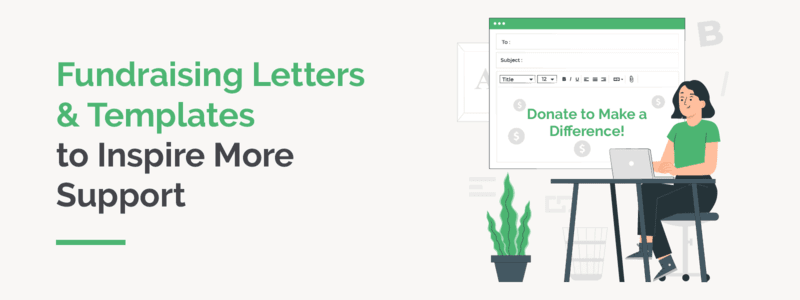


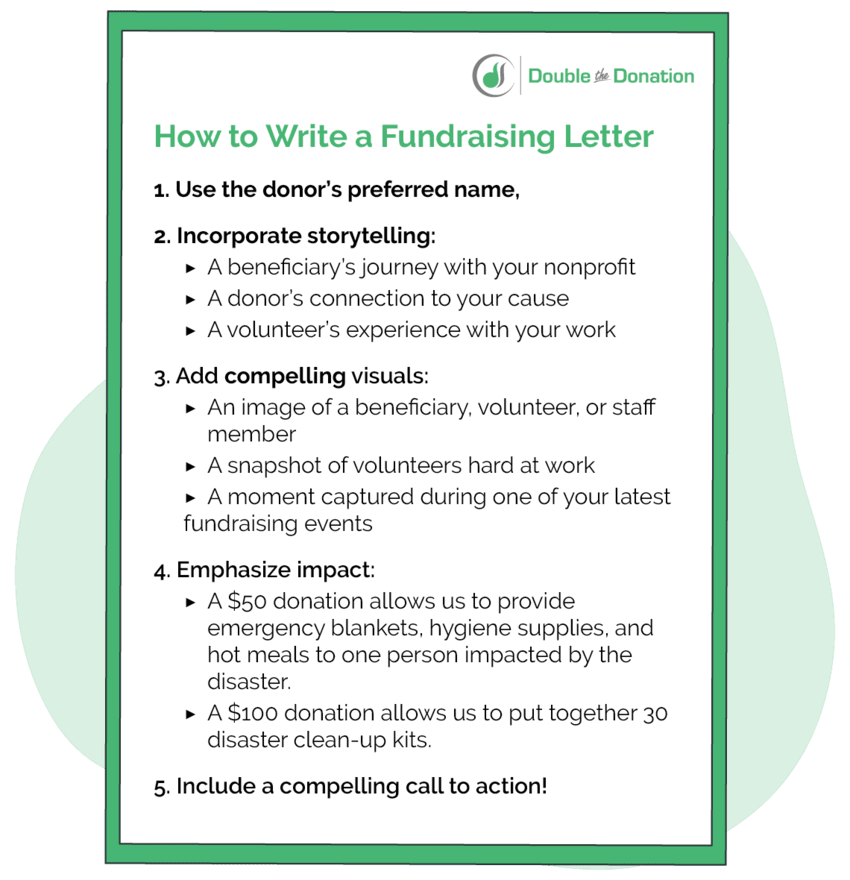
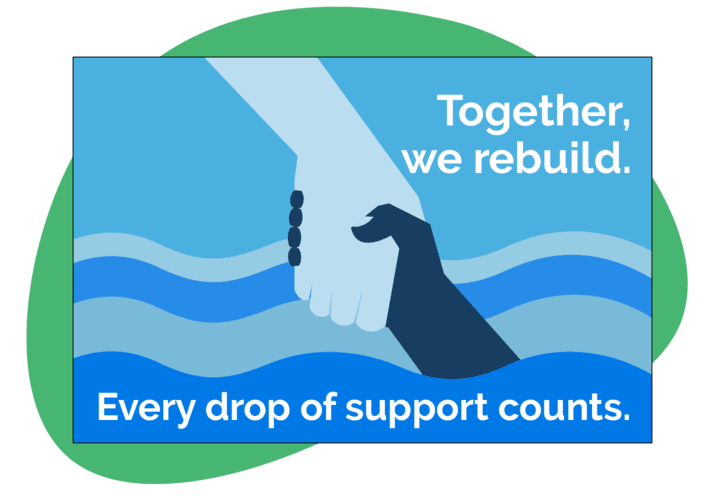


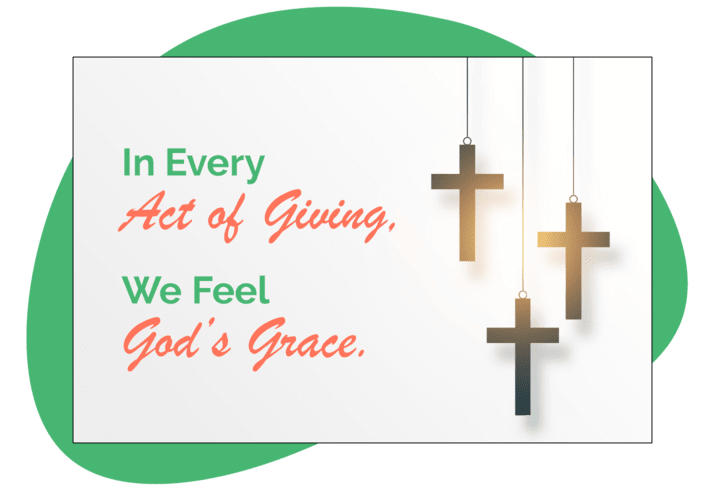

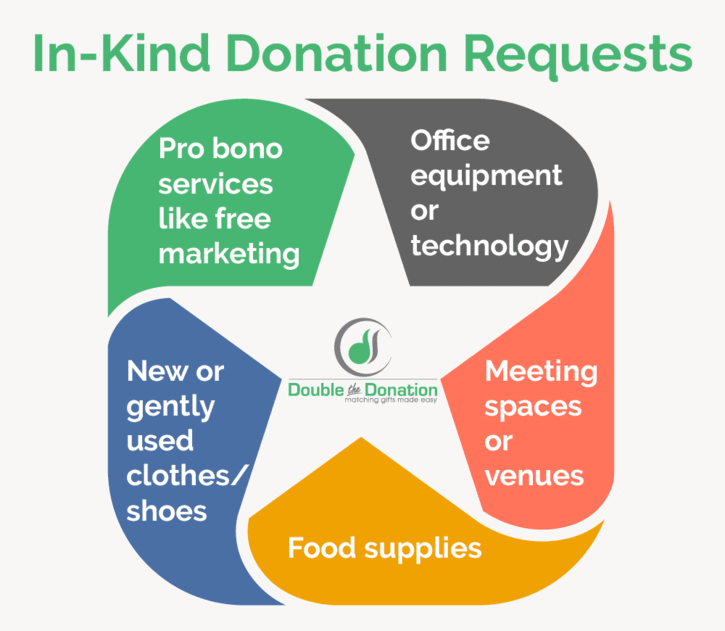






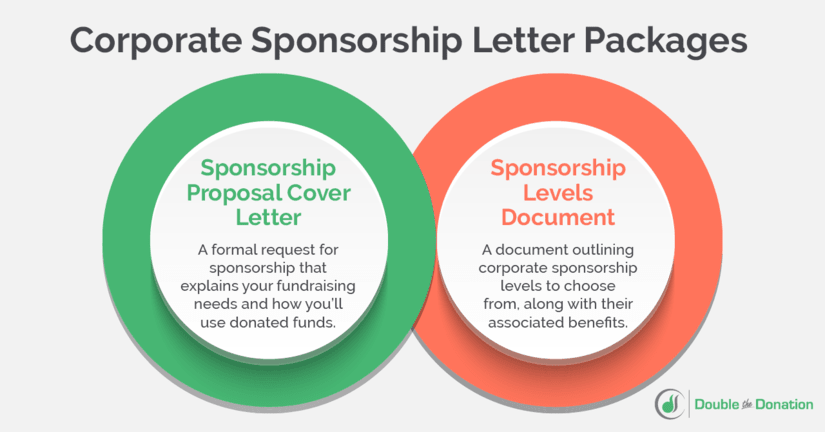

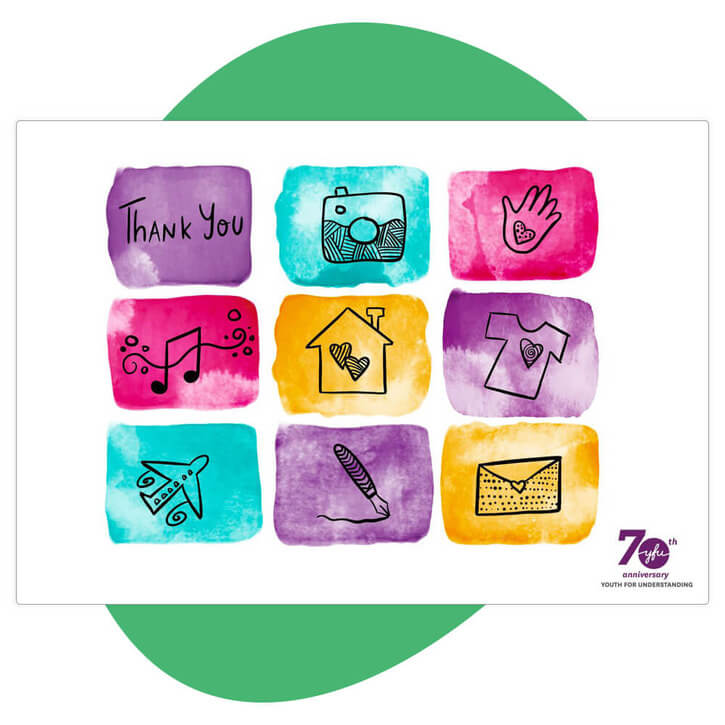


![Learn how eCardWidget can help you revamp your fundraising letters and send them as eCards.]](https://doublethedonation.com/wp-content/uploads/2023/08/Fundraising-Letters_Large-CTA.png)

